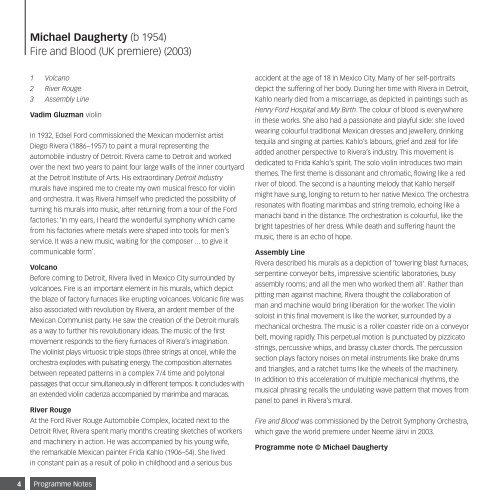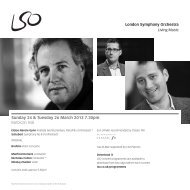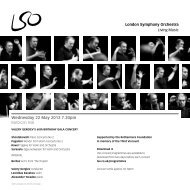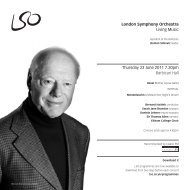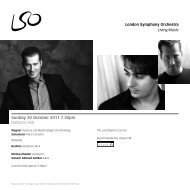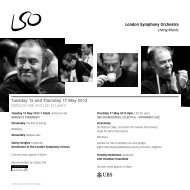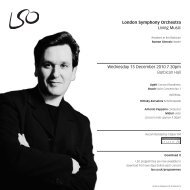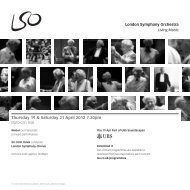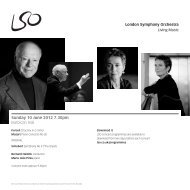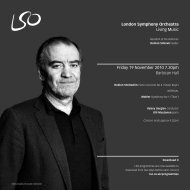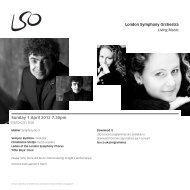Sunday 17 April programme - London Symphony Orchestra
Sunday 17 April programme - London Symphony Orchestra
Sunday 17 April programme - London Symphony Orchestra
You also want an ePaper? Increase the reach of your titles
YUMPU automatically turns print PDFs into web optimized ePapers that Google loves.
Michael Daugherty (b 1954)<br />
Fire and Blood (UK premiere) (2003)<br />
1 Volcano<br />
2 River Rouge<br />
3 Assembly Line<br />
Vadim Gluzman violin<br />
In 1932, Edsel Ford commissioned the Mexican modernist artist<br />
Diego Rivera (1886–1957) to paint a mural representing the<br />
automobile industry of Detroit. Rivera came to Detroit and worked<br />
over the next two years to paint four large walls of the inner courtyard<br />
at the Detroit Institute of Arts. His extraordinary Detroit Industry<br />
murals have inspired me to create my own musical fresco for violin<br />
and orchestra. It was Rivera himself who predicted the possibility of<br />
turning his murals into music, after returning from a tour of the Ford<br />
factories: ‘In my ears, I heard the wonderful symphony which came<br />
from his factories where metals were shaped into tools for men’s<br />
service. It was a new music, waiting for the composer ... to give it<br />
communicable form’.<br />
Volcano<br />
Before coming to Detroit, Rivera lived in Mexico City surrounded by<br />
volcanoes. Fire is an important element in his murals, which depict<br />
the blaze of factory furnaces like erupting volcanoes. Volcanic fire was<br />
also associated with revolution by Rivera, an ardent member of the<br />
Mexican Communist party. He saw the creation of the Detroit murals<br />
as a way to further his revolutionary ideas. The music of the first<br />
movement responds to the fiery furnaces of Rivera’s imagination.<br />
The violinist plays virtuosic triple stops (three strings at once), while the<br />
orchestra explodes with pulsating energy. The composition alternates<br />
between repeated patterns in a complex 7/4 time and polytonal<br />
passages that occur simultaneously in different tempos. It concludes with<br />
an extended violin cadenza accompanied by marimba and maracas.<br />
River Rouge<br />
At the Ford River Rouge Automobile Complex, located next to the<br />
Detroit River, Rivera spent many months creating sketches of workers<br />
and machinery in action. He was accompanied by his young wife,<br />
the remarkable Mexican painter Frida Kahlo (1906–54). She lived<br />
in constant pain as a result of polio in childhood and a serious bus<br />
4 Programme Notes<br />
accident at the age of 18 in Mexico City. Many of her self-portraits<br />
depict the suffering of her body. During her time with Rivera in Detroit,<br />
Kahlo nearly died from a miscarriage, as depicted in paintings such as<br />
Henry Ford Hospital and My Birth. The colour of blood is everywhere<br />
in these works. She also had a passionate and playful side: she loved<br />
wearing colourful traditional Mexican dresses and jewellery, drinking<br />
tequila and singing at parties. Kahlo’s labours, grief and zeal for life<br />
added another perspective to Rivera’s industry. This movement is<br />
dedicated to Frida Kahlo’s spirit. The solo violin introduces two main<br />
themes. The first theme is dissonant and chromatic, flowing like a red<br />
river of blood. The second is a haunting melody that Kahlo herself<br />
might have sung, longing to return to her native Mexico. The orchestra<br />
resonates with floating marimbas and string tremolo, echoing like a<br />
mariachi band in the distance. The orchestration is colourful, like the<br />
bright tapestries of her dress. While death and suffering haunt the<br />
music, there is an echo of hope.<br />
Assembly Line<br />
Rivera described his murals as a depiction of ‘towering blast furnaces,<br />
serpentine conveyor belts, impressive scientific laboratories, busy<br />
assembly rooms; and all the men who worked them all’. Rather than<br />
pitting man against machine, Rivera thought the collaboration of<br />
man and machine would bring liberation for the worker. The violin<br />
soloist in this final movement is like the worker, surrounded by a<br />
mechanical orchestra. The music is a roller coaster ride on a conveyor<br />
belt, moving rapidly. This perpetual motion is punctuated by pizzicato<br />
strings, percussive whips, and brassy cluster chords. The percussion<br />
section plays factory noises on metal instruments like brake drums<br />
and triangles, and a ratchet turns like the wheels of the machinery.<br />
In addition to this acceleration of multiple mechanical rhythms, the<br />
musical phrasing recalls the undulating wave pattern that moves from<br />
panel to panel in Rivera’s mural.<br />
Fire and Blood was commissioned by the Detroit <strong>Symphony</strong> <strong>Orchestra</strong>,<br />
which gave the world premiere under Neeme Järvi in 2003.<br />
Programme note © Michael Daugherty


